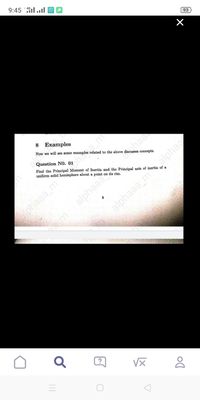Question
thumb_up100%

Transcribed Image Text:9:45 il..l O O
93
8 Examples
Now we will see some examples related to the above discusses concepts.
Question NO. 01
shutam
Find the Principal Moment of Inertia and the Principal axis of
uniform solid hemisphere about a point on its rim.
bertia
alphaaa_m
alphaaa malphae
alphaaa haa
Expert Solution
This question has been solved!
Explore an expertly crafted, step-by-step solution for a thorough understanding of key concepts.
This is a popular solution
Trending nowThis is a popular solution!
Step by stepSolved in 2 steps with 1 images

Knowledge Booster
Similar questions
- In the figure, a constant horizontal force F→app of magnitude 31.0 N is applied to a uniform solid cylinder by fishing line wrapped around the cylinder. The mass of the cylinder is 17.5 kg, its radius is 0.656 m, and the cylinder rolls smoothly on the horizontal surface. (a) What is the magnitude of the acceleration of the center of mass of the cylinder? (b) What is the magnitude of the angular acceleration of the cylinder about the center of mass? (c) In unit-vector notation, what is the frictional force acting on the cylinder?arrow_forwardThe uniform thin rod in the figure below has mass M = 2.00 kg and length L = 3.25 m and is free to rotate on a frictionless pin. At the instant the rod is released from rest in the horizontal position, find the magnitude of the rod's angular acceleration, the tangential acceleration of the rod's center of mass, and the tangential acceleration of the rod's free end.arrow_forwardA solid cylinder of uniform density of radius 2 cm has mass of 50 g. If its length is 10 cm, Calculate its moment of inertia about (i) its own axis of rotation passing through the centre. (ii) an axis passing through its centre and perpendicular to its length.arrow_forward
- A suspended homogeneous rod AB of length, 75 cm and mass of 5 kg is rotating about one of its ends (A) at an angular velocity of 10.24 rad s-1. 1). Calculate the moment of inertia I of this rod. 2) What is the corresponding linear velocity of the free end, B? 3) The end B hits and sticks to a ball of radius R=12.5 cm and mass 850 g moving in the opposite direction with a linear velocity of 5.48 m.s-1. Use the principle of conservation of momentum to find the linear velocity of the ball-rod system after the collisionarrow_forwardA uniform solid sphere of radius r is placed on the inside surface of a hemispherical bowl with radius R. The sphere is released from rest at an angle θ to the vertical and rolls without slipping (Fig.). Determine the angular speed of the sphere when it reaches the bottom of the bowl.arrow_forwardAn automobile traveling 110 km/h has tires of 69.0 cm diameter. (a) What is the angular speed of the tires about their axles? (b) If the car is brought to a stop uniformly in 21.0 complete turns of the tires, what is the magnitude of the angular acceleration of the wheels? (c) How far does the car move during the braking? (Note: automobile moves without sliding) (a) Number i Units (b) Number i Units (c) Number i Unitsarrow_forward
- NASA physicians need to know whether the contents of astronauts' skulls (brain, eyes, eardrums, etc.) move so much during rotational maneuvers that injury might be caused. If you are an astronaut in a spinning spacecraft and have an initial angular displacement of 3.14 radians, an initial angular velocity of 3.683 radians per second, and an angular acceleration of 0.02 radians per second squared, what distance will your eyes have traveled around the center of your skull after 26.83 seconds?arrow_forwardA uniform, solid cylinder with mass M and radius 2R rests on a horizontal tabletop. A string is attached by a yoke to a frictionless axle through the center of the cylinder so that the cylinder can rotate about the axle. The string runs over a disk-shaped pulley with mass M and radius R that is mounted on a frictionless axle through its center. A block of mass M is suspended from the free end of the string (the figure (Figure 1)). The string doesn't slip over the pulley surface, and the cylinder rolls without slipping on the tabletop. Find the magnitude of the acceleration of the block after the system is released from rest. Express your answer in terms of g, M, R.arrow_forward
arrow_back_ios
arrow_forward_ios